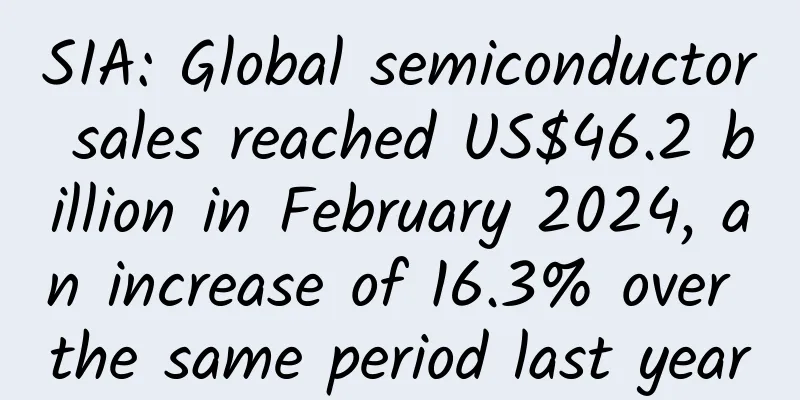SIA: Global semiconductor sales reached US$46.2 billion in February 2024, an increase of 16.3% over the same period last year

|
The Semiconductor Industry Association (SIA) announced on April 3 that global semiconductor industry sales totaled $46.2 billion in February 2024, up 16.3% from $39.7 billion in February 2023, but down 3.1% from $47.6 billion in January 2024. "While sales were down slightly month-over-month, global semiconductor sales in February were still well ahead of the totals for the same month last year, continuing the market's strong year-over-year growth momentum since the middle of last year," said John Neuffer, SIA president and CEO. "February's year-over-year sales growth was the largest percentage increase since May 2022, and market growth is expected to continue throughout the remainder of the year." Regionally, like-for-like sales increased in China (28.8%), the Americas (22.0%), and Asia Pacific/All Other (15.4%), but decreased in Europe (-3.4%) and Japan (-8.5%). Monthly sales decreased in all markets: Asia Pacific/All Other (-1.3%), Europe (-2.3%), Japan (-2.5%), the Americas (-3.9%), and China (-4.3%). The State and Outlook of the Semiconductor Supply Chain in 2024 and Beyond From a top-down perspective, semiconductor demand is weak and electronic equipment manufacturing is sluggish. The S&P Global Manufacturing Purchasing Managers Index shows that new orders have fallen in 18 of the past 19 months. We are seeing some signs of recovery, with the rate of decline decreasing and new orders for communications equipment increasing. This is still a long way from the pace of expansion seen during the boom years of 2021. There are also signs of recovery in semiconductor exports from the major manufacturing hubs of Taiwan and South Korea. Demand for generative AI is providing a welcome boost to chip, system and cloud vendors at a time when sales of general-purpose computing infrastructure have stagnated. The market is still early in its development cycle. The huge demand for GPUs is driven in large part by a small group of forward-thinking companies building their own base platforms, coupled with Chinese mainland companies buying up as many advanced GPUs as they can before further export restrictions take effect. This rush is likely to be followed by a lull before most commercial companies are ready to use these models at scale in real revenue-generating applications. The timing of this will be determined by the usual sequence of development, testing, and previewing before general availability is achieved. Large-scale training is the most pressing need today, but over time inference will become by far the larger market opportunity, so some of the large training clusters built today may be repurposed for inference as demand returns — potentially leading to an overall slowdown in infrastructure sales as the overhang is absorbed. Hyperscalers use GPUs in two ways: internally to pre-train their own large-scale base models for customer use, and externally to provide customers with GPU-powered instances to run their own AI models and code. Increasingly, they are developing their own custom silicon accelerators as a supplement or alternative to GPUs. Unless performance and efficiency can improve exponentially, the projected growth in data center capacity over the next decade will not be achieved. This shift is a major disruption for the semiconductor industry. Capital expenditures of the four hyperscale companies that released relevant data reached US$30.8 billion in the fourth quarter of 2023, a year-on-year increase of 15% and a 95% increase compared with the same period in 2019. Over the past five years, shipments of consumer devices have driven the semiconductor industry through boom-and-bust cycles. In the long term, the global consumer technology and related platform markets are directly tied to the rollout of next-generation connectivity via fiber and 5G, and their increasing maturity in 2024 will further accelerate market development. New products and applications will continue to emerge, many of which are driven by AI and rely on system-on-chip technology to accelerate AI through an integrated combination of CPU, GPU and neural processing unit (NPU). Many PC manufacturers are counting on the launch of "AI PCs" in late 2024 to stimulate demand. In the short term, our forecasts show that North American smartphone shipments have been in a persistent slump since 2016, with no recovery expected until 2027. Shipments of home media devices (including video game consoles, TVs, and streamers) grew 16% in 2020, will decline 10% in 2021, and then fall 17% in 2022 and 2023 combined. Game console shipments are expected to decline, while streamers and smart TVs are expected to grow only 1% to 3% over the next four years. AI use cases are likely to be a key driver of sales of infrastructure located outside of centralized public clouds and data centers, close to end users, connected machines and sensors. The global mobility industry is undergoing an industry-changing digital transformation, such as the in-car and out-of-car infrastructure required to support the vision of connected cars, potentially enabling autonomous driving. These rely heavily on intelligent edge infrastructure deployed, managed and owned by OEMs, industry suppliers, hyperscalers, data center providers and 5G service providers. A continued supply of less advanced “legacy” semiconductors and ultra-low power chips with additional embedded intelligence is an important part of this vision. Repurposed consumer chips and emerging architectures — RISC-V cores, software IP and chiplets — must be adopted more quickly by current embedded processing and microcontroller chip specialists who are not always at the forefront of technology innovation. The industry may have a bright long-term future, but the immediate outlook is bleak, and there is no getting around the challenge. This can be clearly seen in the middle of the technology supply chain, where exports of some semiconductors have yet to begin to recover. Trade data for semiconductor parts will be a key indicator for tracking a recovery in actual chip demand. Observations from the semiconductor industry |
<<: Windows 10 Mobile's critical bug has been fixed
>>: PNY launches OTG USB flash drive: can be used on mobile phones and computers
Recommend
Some thoughts on Android APP performance optimization
When it comes to Android phones, most people have...
Is Toutiao’s promotion effective? How much does it usually cost?
Toutiao promotion is a combination of information...
Breaking news! US District Court urgently stops WeChat from being removed from the platform
Late at night on September 20th, Beijing time, ac...
10,000-word article | In-depth analysis of the promotion and operation strategy behind Douyin
Since I started my content entrepreneurship , I h...
20 early signs of cancer, check yourself now!
In the past, people had the impression that cance...
What is more terrifying than the non-existence of physics is pi丨Happy Pi Day
In The Three-Body Problem, before committing suic...
From 2019 to 2020, these 4 marketing trends will not change
2019 has finally come to an end. This year the ma...
Why has SEM network promotion had no effect for many years?
The low conversion rate of SEM promotion is a com...
Life is not easy! A 60-year-old courier sorter died suddenly in the early morning. You must know the truth about sudden death.
Recently, the topic of "60-year-old ZTO Expr...
Mitsubishi China recalls imported ASX and Pajero Sport
Recently, Mitsubishi Motors Sales (China) Co., Lt...
How to add negative keywords in batches in Baidu bidding?
(1). How to add negative keywords in batches in B...
E-commerce detail page conversion skills worth 50,000 yuan (1)
When users break through layers of screening and ...
12 tips | Key points you need to know about creating advertising slogans
I won’t accept any gifts this year, and if I do, ...
Go exercise in the spring, but be careful, the harder you exercise, the more "injured" you will be...
Take off the down jacket! The woolen coat is off!...
How much does it cost to develop a shopping mall mini program in Liaocheng?
There is no fixed price for the development of th...









